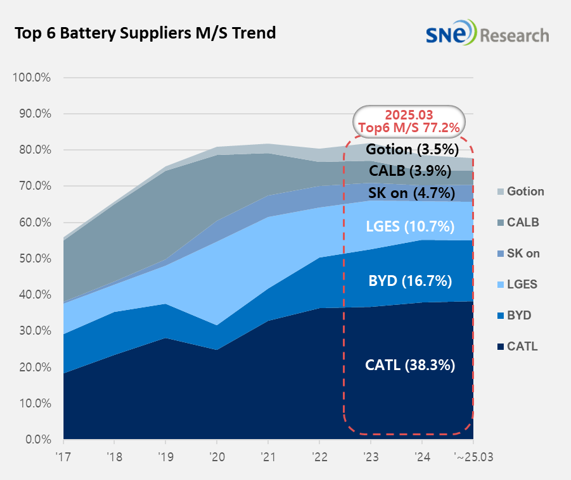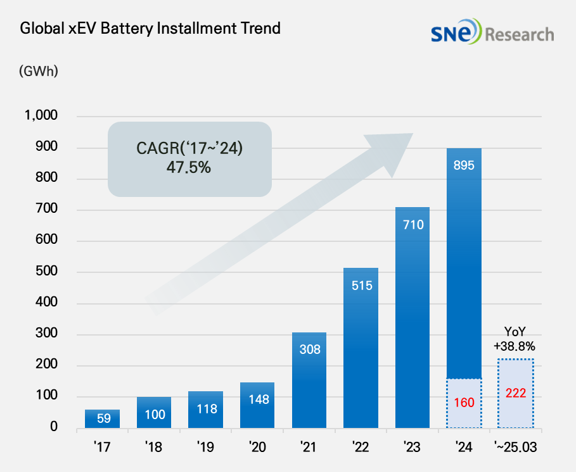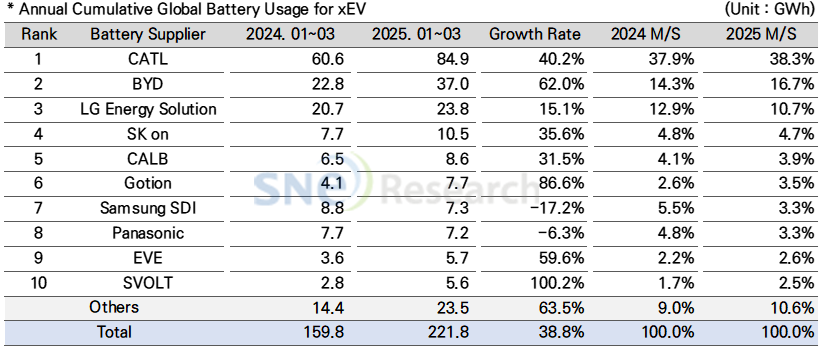From Jan to Mar 2025, Global[1] EV Battery Usage[2] Posted 221.8GWh, a 38.8% YoY Growth
- From
Jan to Mar 2025, K-trio’s M/S recorded 18.7%
(Source: 2025 Apr Global Monthly EV and Battery Monthly Tracker, SNE Research)
(Source: 2025 Apr Global Monthly EV and Battery Monthly Tracker, SNE Research)
If we look at the usage of battery made by the K-trio in terms of the
sales volume of models, Samsung SDI’s battery was mainly used in BMW, followed
by Audi and Rivian. BMW recorded steady sales of models equipped with Samsung
SDI’s battery such as i4, i5, and iX. However, the launch of standard-range
trims for Rivian’s R1S and R1T, equipped with LFP batteries made by a battery
maker other than Samsung SDI, had a negative impact on Samsung SDI’s battery
usage. Audi also saw a decline in the sales of Q8 e-Tron, resulting in a
negative growth in the usage of Samsung SDI’s battery.
SK On’s battery was mainly installed in EV models made by Hyundai Motor
Group, followed by Mercedes-Benz and Volkswagen. Hyundai Motor Group saw a
recovery in sales after the facelifted versions of IONIQ 5 and EV6 were
released. Mercedes-Benz saw favorable sales of compact SUVs EQA and EQB, to
which SK On’s battery is installed, maintaining a stable performance similar to
the same period of last year. Along with this, strong sales of VW ID.7 and ID.4
had a positive impact on the growth of battery usage made by SK On.
Panasonic, which mainly
supplies batteries to Tesla, recorded 7.2GWh in battery usage and ranked 8th on
the list. Given its high dependence on Tesla, the decline in Tesla’s sales this
year—driven by lower demand for Model 3 and Y—was the main reason behind
Panasonic’s decreased battery usage. However, Panasonic is expected to quickly
recover its battery usage in North America, centered around Tesla, with the
release of improved 2170 and 4680 cells.
China’s CATL maintained its solid position as the global No.1 battery
maker, posting 40.2% (84.9GWh) YoY growth. In addition to key OEMs such as
ZEEKR, AITO, Li Auto, and Xiaomi adopting CATL’s batteries, many global major
OEMs including Tesla, BMW, Mercedes-Benz, and Volkswagen are also using CATL’s
batteries.

(Source: 2025 Apr Global Monthly EV and Battery Monthly Tracker,
SNE Research)
After Trump’s re-election, the U.S. has officially implemented strong
tariff policies on Chinese batteries and raw materials, reigniting tension
across the global supply chain. In response, Korean battery companies are
expanding joint ventures with local OEMs and reinforcing their strategy to
increase the share of production in the U.S. in order to secure continued
eligibility for incentives in the North American market. However, given the
industry’s high dependence on Chinese materials, mid- to long-term efforts to
restructure the supply chain and diversify raw material sourcing have become
urgent. Ultimately, the Korean battery industry must seek new growth strategies
amid a complex environment shaped by intensified U.S. protectionism, stricter
environmental regulations in Europe, and rising price pressure from China.
[2] Based on battery installation for xEV registered during the relevant period.



